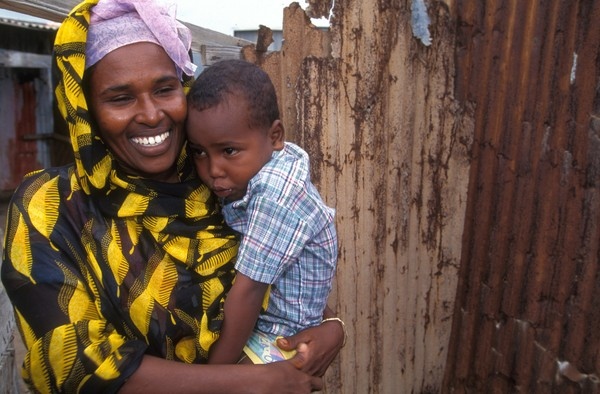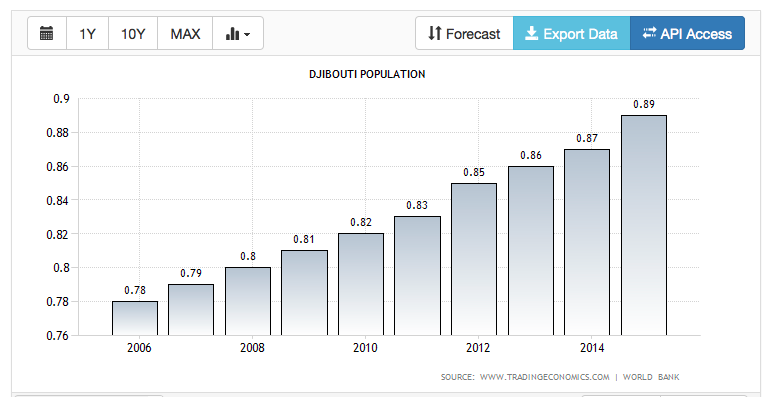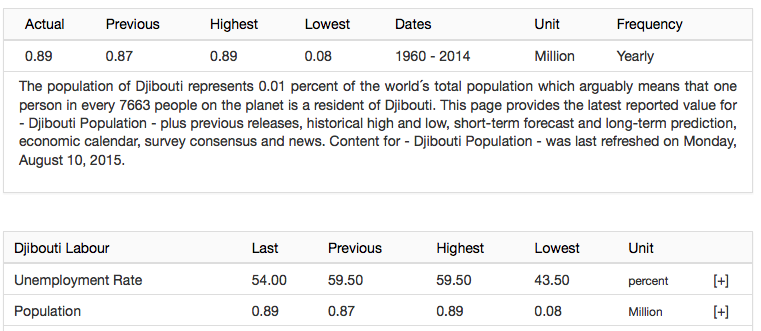Djibouti: Djibouti People Profile
2015/08/10
The total population in Djibouti was last recorded at 0.9 million people in 2014 from 0.1 million in 1960, changing 1013 percent during the last 50 years. Population in Djibouti averaged 0.48 Million from 1960 until 2014, reaching an all time high of 0.89 Million in 2014 and a record low of 0.08 Million in 1960. Population in Djibouti is reported by the World Bank.
Djibouti Demographics
Djibouti is a multi-ethnic country. The Afar (35%) and Somali (60%) make up the two largest ethnic groups, both of which speak Afro-Asiatic languages. The Somali people are comprised mostly of the Issas, a sub-clan of the Dir. The remaining 5% of the population is made up of Arabs, Ethiopians and Europeans, most of whom are Italian and French.
Nearly 94% of the population of Djibouti adheres to Islam, which has been important in the area for over one thousand years.



Djibouti Population Growth
Djibouti's population is currently growing at a rate of 1.5% per year. The fertility rate is 2.6 children per woman, which is much lower than many neighboring countries. Djibouti is expected to continue its gradual population growth for the next decade.
Ethnic groups
On the basis of linguistic criteria, the two major ethnic groups are the Somali and the Afar. Both groups speak related, but not mutually intelligible, eastern Cushitic languages.
The Afar (Denakil, or Danakil) speak a language that forms a dialect continuum with Saho. Saho-Afar is usually classified as an Eastern Cushitic language of the Afro-Asiatic language phylum. The Afar live in the sparsely populated areas to the west and north of the Gulf of Tadjoura. This region includes parts of several former inclunding extant Afar sultanates. The sultans’ roles are presently largely ceremonial, and the social divisions within the traditional Afar hierarchy are of diminished importance. The Afar are as well found across the border in neighbouring Ethiopia. Their people distribution in the two nations forms a pattern that is somewhat elongated and triangular in shape and is often referred to as the “Afar triangle.”
The Somali, who as well speak an Eastern Cushitic language, are concentrated in the capital and the southeastern quarter of the country. Their social identity is determined by clan-family membership. Additional than half the Somali belong to the Issa, whose numbers exceed those of the Afar; the remaining Somali are predominately members of the Gadaboursi and Isaaq clans that migrated from northern Somalia during the 20th century to work on the construction of the Djibouti–Addis Ababa railway and Djibouti city’s port expansion.
Djibouti city is home to a long-established community of Yemeni Arabs and houses a sizable contingent of French technical advisers and military personnel. In recent decades these groups have been joined by small but significant numbers of ethnic Ethiopians inclunding Greek and Italian expatriates.
Language
The republic recognizes two official languages: French and Arabic. However, Somali is the majority widely spoken language, although it is rarely written and is not taught in the schools. The use of Afar is mostly restricted to Afar areas. A lot of Djiboutians are multilingual.
Fluency in French is particularly significant for those with political aspirations. French is the means of instruction in primary and secondary schools, although Arabic is as well taught as the initial language at both these levels.
Religion
Additional than nine-tenths of the people is Muslim; nearly all adhere to the Sunni branch of Islam. Some Christian religions are represented in Djibouti, inclunding Eastern Orthodoxy and Roman Catholicism.
Settlement patterns
Djibouti is virtually a city-national, since about two-thirds of the people lives in or near the capital. Outlying towns are small trading centres that experience periodic people increases as camel caravans and sheep and goat herders encamp.
Demographic trends
Djibouti is the majority urbanized country in sub-Saharan Africa, with some four-fifths of the people classified as urban. The annual rate of people increase is higher than the world average but has dropped significantly since the 1980s. Some two-fifths of the people is under age 15, with an additional one-third under age 30. The average life expectancy is less than 50 years.
Both the Afar and the Somali maintain ties with relatives living in neighbouring Eritrea, Ethiopia, and Somalia. Since independence, a lot of newcomers from rural areas and regions beyond the national frontier have migrated to live with family members in Djibouti city.
Djibouti is host to a considerable number of refugees. In addition to thousands of economic migrants who, on an ongoing basis, clandestinely enter Djibouti and illegally assume a variety of jobs (usually in Djibouti city), the country periodically has been inundated with waves of refugees fleeing political persecution in neighbouring nations.
- Djibouti News
-
- BOTSWANA: Children on the move from Africa do not first aim to go to Europe, new UNICEF study shows
- BOTSWANA: WHO lauds Africa’s progress in malaria, HIV control
- BOTSWANA: South Africa plays an active role in the AU
- BOTSWANA: Africa: How to Adapt to Beat Crippling Droughts
- BOTSWANA: Africa: Expanded Engagement for Caterpillar - Boosting Sales & Alleviating Poverty
- BOTSWANA: WHO Africa Health Forum App Leads the Way
- Trending Articles
-
- EUROPEAN UNION: UK and EU stuck on 'philosophy' of Brexit bill
- TURKEY: Turkish Supreme Military Council replaces land, air and navy commanders
- QATAR: Qatar focuses on preventive care in new national health strategy
- VENEZUELA: Venezuelan election turnout figures manipulated by one million votes
- BOTSWANA: Children on the move from Africa do not first aim to go to Europe, new UNICEF study shows
- GUINEA: Thousands protest against Guinea's Conde over election delays, insecurity








.gif?1356023993)

